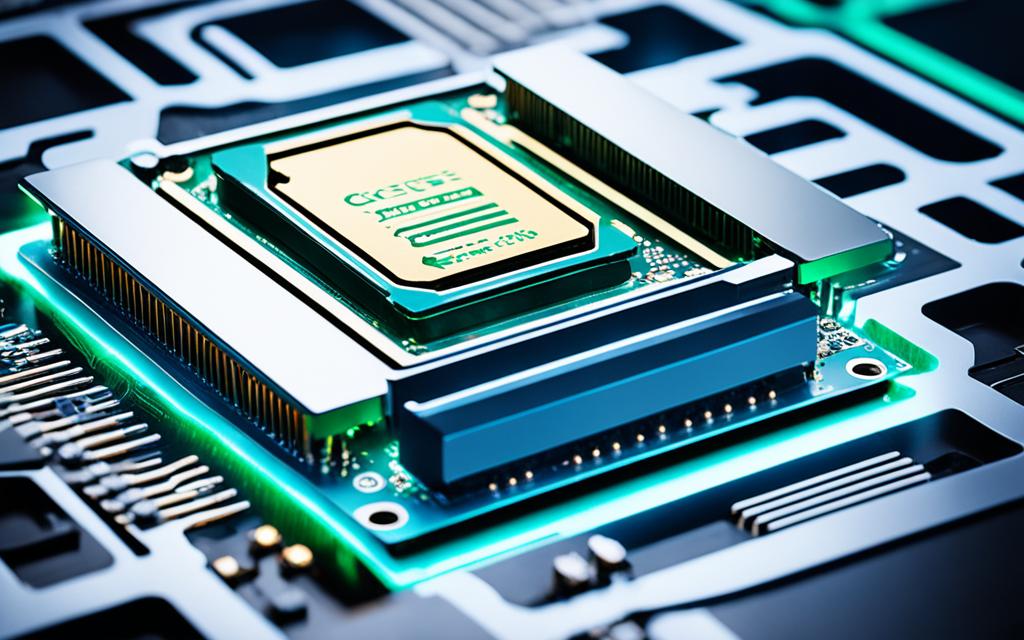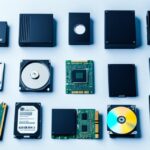Table of Contents
Computational storage is becoming key in managing data more effectively. It started to gain attention in 2018, but its ideas were around since 2012. This technology integrates processing within storage devices. It helps meet the growing need for efficient data handling. As we near the limits of Moore’s Law and the Von Neumann architecture, we see more clearly the need for innovative solutions like computational storage.
One big problem in data centres is how much energy is used just to move data around, which accounts for over 40% of the total energy used. Computational storage offers a way to cut down on this by using specialized processors. These processors make it possible to handle data more efficiently. This not only saves energy but also speeds things up and opens new doors for data processing advances. Solidigm is at the forefront, pushing computational storage forward as demand grows across different industries. They aim for a future where data centres are far more energy-efficient, potentially cutting energy use by up to 90% for some tasks1.
For a more in-depth look at this exciting area, check out an excellent overview available here.
Key Takeaways
- Computational storage is redefining data processing by integrating computation within storage systems.
- It aims to alleviate challenges related to energy consumption and latency in data centres.
- As companies pursue greater storage efficiency, collaborations and investments in technology will be essential.
- Expected growth in cloud services is poised to drive the demand for innovative computational storage solutions.
- Key players in the market are innovating to solidify their leadership in the sector.
Understanding Computational Storage
Computational storage is changing how we think about data storage. It blends storage with processing power inside the devices themselves. This approach allows data to be processed where it’s stored. This boosts both performance and efficiency. Let’s dive into how it works and why it’s different from what we’ve been used to.
Definition and Overview
Computational storage marks a new era in data management. In the past, data had to move to CPUs for any processing, causing delays and bottlenecks2. Now, with computational storage, data is analysed right where it’s stored. This reduces the need to move data for processing. It’s especially valuable as IoT devices and large-scale computing grow, generating vast amounts of data2.
How It Differs From Traditional Storage
Let’s look at the key differences between traditional and computational storage. There are two types of computational storage services: fixed and programmable3. This lets businesses pick the best option for their needs. Tech leaders like Tesla and Google are already using computational storage. It’s great for handling large amounts of data quickly3.
On the other hand, traditional storage can’t keep up with big data very well. Why? Because moving data uses about 62 percent of computing energy4. Computational storage cuts down on this energy use. It makes processing large data sets more efficient and sustainable4.
| Feature | Traditional Storage | Computational Storage |
|---|---|---|
| Data Processing Location | Centralised CPU | In-Situ (At Storage) |
| Performance Speed | Higher Latency | Real-time Analysis |
| Energy Consumption | High data movement cost | Reduced power usage |
| Market Applicability | General data storage | IoT, edge computing, hyperscale datacentres |
The Evolution of Computational Storage Technology
The journey through the evolution of computational storage has been full of big steps. These changes have greatly changed how we handle and process data. In recent years, there’s been a big shift due to the start of computational storage platforms. These have now become a key part of the market. Companies like Samsung, NGD, and Scale-Flux are leading the way. They offer SSDs that come with computational storage features. This shows a market that’s eager to use what this technology can offer5.
Historical Context and Development
Computational storage started with a focus on making computing faster. This was done using technologies like GPUs and ASICs. These technologies helped with AI and machine learning tasks6. Then, there was a shift towards making networks and storage faster. This brought attention to technologies like FPGAs, SmartNICs, DPUs, and IPUs. These new technologies aim to bring computing closer to where data lives. This makes finding, processing, and changing data more effective6.
Key Milestones in Computational Storage
There have been several important moments in the development of computational storage. Groups like NVM Express and SNIA have worked to create standard ways of structuring and commanding block storage. This makes it better suited for computational storage6. Recent progress includes SSDs that have their own processors and memory. This includes multicore CPUs, FPGAs, and DRAM. These developments help cut down on energy use. They reduce the power needed from a typical 100W of a host CPU to just 25W5. However, there are still hurdles, like limited computing power. There’s also the task of writing precise code to make the most of user-defined tasks5. As more businesses get involved in computational storage, we’re moving towards systems that can handle data on their own. This could make finding and modifying data automatic6.
Market Trends Impacting Computational Storage
The landscape of computational storage is changing fast. New market trends are shaping its future as we speak. Various industries are embracing these changes, leading to a need for better storage solutions.
Current Adoption Rates Across Industries
In 2023, the value of the global computational storage market was USD 6.50 billion. It’s expected to grow to USD 17.82 billion by 2030. This growth, at a Compound Annual Growth Rate (CAGR) of 15.5% from 2024 to 20307, reflects the rising demand. Data-heavy applications in healthcare, finance, and the Internet of Things (IoT) are driving this trend. North America is at the forefront, thanks to healthcare’s need for managing large patient data7. There’s an expected rise in global data volume to 175 zettabytes by 2025, showing an urgent need for efficient storage solutions7.
Challenges Facing Computational Storage in the Marketplace
Yet, the path to widespread use of computational storage isn’t without challenges8. The main obstacles include high setup costs and the complexity of the technology. Businesses also worry about meeting regulatory standards8. To integrate computing resources into storage systems, companies need to invest in new technologies. They must also update their existing applications, which adds to the burden8.
Understanding security and handling potential threats is key to overcoming these hurdles9. A well-informed approach can foster trust and pave the way for acceptance. The speed at which computational storage becomes commonplace will depend on how well these challenges are addressed and the opportunities seized.
| Year | Global Market Size (USD) | Projected Market Size (USD) | CAGR (%) |
|---|---|---|---|
| 2023 | 6.50 Billion | – | – |
| 2024 | – | 15 Billion | 9.95 |
| 2030 | 17.82 Billion | 29.14 Billion | 15.5 |
| 2031 | – | 29.14 Billion | – |
Benefits of Embracing Computational Storage
Computational storage brings big benefits for businesses. The biggest are better data efficiency and less energy use. This tech does computations right where the data is stored. This cuts down the need to move data around a lot. Because of this, it uses less energy. This can save businesses a lot on costs. It’s said that by 2025, the world’s data will hit 175 ZB. This shows how much we need good data management today10.
Enhanced Data Processing Efficiency
Computational storage makes data work faster. It uses devices with many-core CPUs which are great for doing many tasks at once. This boosts performance11. It’s really useful for things like edge computing and analyzing data. These areas need to process data quickly, especially for AI. Phison is working on a big computational storage solution. This will help bring this technology to many different areas. It will improve speed and how responsive these systems are10.
Reduction in Latency and Energy Consumption
Putting computing in storage devices is key for better performance on big data tasks11. With computational storage, data gets processed locally. This means faster results and better experiences for users. As more businesses use edge computing, these benefits become even clearer. They help businesses stay ahead of the competition. At the same time, they use less power. This shows how valuable computational storage can be10.
FAQ
What is computational storage?
Computational storage combines processing ability within storage devices. This setup executes tasks close to where the data is stored. It boosts efficiency and cuts down on the need to move data extensively.
How does computational storage differ from traditional storage?
In contrast to traditional storage that moves data to a central processor, computational storage processes data within the device itself. This leads to better efficiency, less waiting time, and decreased power use.
What are the main benefits of adopting computational storage?
Benefits include more efficient processing, reduced delays, and lower energy consumption. It’s especially useful for sectors requiring quick data analysis and fast content delivery.
What challenges does computational storage face in the marketplace?
Challenges involve adapting current applications and understanding new security needs. These issues affect how quickly businesses can start using computational storage.
How has the technology of computational storage evolved over the years?
Since 2018, computational storage has seen major growth, with standardization efforts by groups like SNIA. Innovations such as NVMe SSDs and adoption by big companies like Amazon have been key.
Which industries are adopting computational storage technology?
Cloud computing and AI are leading in adopting this tech. Companies such as Tesla and Google are using it for better data handling.
What does the future hold for computational storage?
Computational storage’s future looks bright as it adapts to overcome current tech limitations. We’ll see more advancements and broader use in business practices.
Source Links
- https://netzero-events.com/why-is-computational-storage-in-data-centers-ideal/ – Why Is Computational Storage in Data Centers Ideal? – Future Bridge NetZero Events
- https://www.techtarget.com/searchstorage/definition/computational-storage – What is computational storage? | Definition from TechTarget
- https://www.informationweek.com/it-infrastructure/understanding-the-benefits-of-computational-storage – Understanding the Benefits of Computational Storage
- https://newsroom.arm.com/blog/computational-storage – Computational Storage: A New Way to Boost Performance
- https://www.cidrdb.org/cidr2021/papers/cidr2021_paper29.pdf – PDF
- https://www.dell.com/en-us/blog/rise-of-data-centric-computing-with-computational-storage/ – Rise of Data-Centric Computing with Computational Storage | Dell
- https://www.nextmsc.com/report/computational-storage-market – Next Move Strategy Consulting
- https://medium.com/@nishantkumar953499/global-computational-storage-drives-market-size-share-growth-demand-trend-2024-2030-a55be5f2c5b8 – Global Computational Storage Drives Market Size, Share, Growth, Demand, Trend 2024–2030
- https://www.linkedin.com/pulse/global-computational-storage-market-share-thriving-f3vyc/ – Global Computational Storage Market Share | Thriving worldwide | Findings
- https://phisonblog.com/why-is-computational-storage-inevitable-2/ – Why Is Computational Storage Inevitable? – Phison Blog
- https://www.linkedin.com/pulse/what-computational-storage-good-idea-right-you-well-help-gallegos – What is computational storage? Is it a good idea? Is it right for you? What are the benefits? We’ll help you find out.








